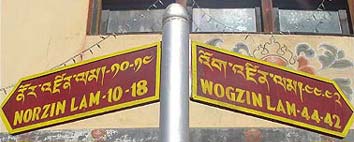|
Dzongkha:
Bhutan's national language
|
 |
Bhutan's
Culture: Dzongkha |
|
 |
Bhutan Information |
|
|
 |
|
The
history of the Development of Dzongkha dictionaries
|
 |
 |
| The
publication of three Dzongkha dictionaries in 2000 will definitely
encourage efforts to develop the national language. The English-
Dzongkha Dictionary (By Kunzang Thinley and Tenzin Wangdi: KMT Printers;
413 pages. Nu 225) and My Picture Dictionary (By Garab Dorji: |
|
World
Wildlife Fund; 73 pages. Nu.200), which is yet to be released, are,
in their design and purpose, new developments in the history of Bhutanese
lexicography.
The
Dzongkha-English Dictionary, which will be published by the Dzongkha Development
Commission (DDC) by the end of 2000 will have over 10,000 entries.
But the Choeked-Dzongkha Dictionary, being compiled by Geshe Tenzin Wangchuk,
a researcher at the DDC, will be the most comprehensive and authoritative
one. It will have over 100,000 entries.
The
Choeked-Dzongkha Dictionary will be a landmark in the history of Bhutanese
lexicography. Vernacular Dzongkha has been spoken for hundreds of years
in the country, often with dialectic variation in Haa, Paro, Thed (Punakha)
and Wang (Thimphu). There are instances of vernacular Dzongkha writings
dating back to the 17th century as reported in a document, which
will soon be published by the DDC. However, it was only in 1961 when the "first systematic efforts were undertaken to 'modernise' and codify
the national language".
It was in the same year His Late Majesty
Jigmi Dorji Wangchuck decreed Dzongkha as Bhutan's national language. Before
Dzongkha, Choeked was taught in modern secular Bhutanese schools, even
until 1971 due to the unavailability of Dzongkha materials. The
breakthrough came when the Dzongkha Division of the Education Department
started developing Dzongkha materials.
The
first serious Dzongkha Dicitionary was published by the Text Book Division
of the Education Department in 1986. It was compiled by Kunzang
Thinley, the co-author of the new English-Dzongkha Dictionary, and Choki
Dendup. The year really marked the beginning of dictionary compilation
in Bhutan. Before that, the development of Dzongkha grammar, manuals and
guidebooks assumed greater importance. In fact Dzonkha grammar was extremely
necessary to differentiate the evolving written Dzongkha from Choeked.
The New Method Dzongkha Hand Book published in 1971 and written
by Bhutan's contemporary scholars like Lopen Nado, Lopen Pemala and Lopen
Sanga Tenzin were used for many years in schools in Bhutan. There
were attempts to develop grammar, dictionary and manuals in Sharchop all
along. Pastor Ralph Hofrenning wrote the first manual of Sharchop grammar
in 1955. According to him, 'it is the firstgrammar ever attempted in Gongar,
an unwritten language of the far east'. Dasho Tenzin Dorji's unpublished
Thongwa Zumshor is a Choeked-Sharchop manual. The latest one is perhaps
Susanna Egli-Roduner's Handbook of the Sharchokpa-Lo/Tsangla published
in 1987.
 |
An
interesting development however, was the compilation of an Anglo-Bhutanese
Dzongkha by Fr. Phillip S.D.B, principal of Don Bosco Technical School,
Phuntsholing in 1971. In absence of Dzongkha typewriters, all typed English
entries were followed by meanings in Dzongkha, which were laboriously written
in longhand. This perhaps is the first bilingual dictionary in Bhutan.
Choeked
is the basis of written Dzongkha, and therefore, Dzongkha dictionaries,
in their origin heavily rely on Choeked. Lam Choechong's Choeked-Dzongkha
Dictionary (Q-Reprographics, 1997), the first of its kind has 5881 entries.
It is based mainly on the Choeked dictionary of Pelkhang Lotsawa written
in 1538. Pelkhang Lotsawa was a disciple of the Eighth Karmapa Michoe
Dorji.
The
Dzongkha Dictionary, published by the DDC in 1993, is the largest
so far, with a total of 7932 words. This and the one published in 1986 are the only two Dzongkha dictionaries. Rinchen Khandu's Dzongkha-English
Dictionary is perhaps the first dictionary that uses Dzongkha romanization.
Romanzation of Dzongkha was officially adopted in 1991. It therefore, addresses
audience, especially foreigners who wishes to learn Dzongkha. But there
were already manuals and guidebooks, which either used romanization or
phonological transcription, intended to teach Dzongkha to foreigners.
A
Guide to Dzongkha in Roman Alphabet written in 1971 by Lt. Rinchen Tshering
(RBA) and Major A. Daityar (IMTRAT), A Manual of Spoken Dzongkha by Imaeda
Yoshiro and Dzongkha Rabsel Lamzang published by the DDC in 1990 are a
few examples. Those who want to learn Dzongkha will find the two new dictionaries
helpful. However, there are many distinctions between them, the foremost
being what each title suggests: an English-Dzongkha dictionary and a picture
dictionary. They are thus very different in style, presentation and content
as well. The former has 2120 entries in Dzongkha and 1705 in English. In
it, the meanings of words are not given but the words themselves are used
in the sentences that follow.
The
meanings in Dzongkha are then given, again followed by sentences. Its major
drawback is the assumption that users know meanings of words either in
Dzongkha or English and would be able to read the other to understand its
corresponding meanings. It requires users to have a good command of both
English and Dzongkha. It is currently being reviewed by the CAPSD, Education
Division to consider its usage in schools. With an entry of over 600 words
and pictures and illustrations, My Picture Dictionary is especially designed
for children. Beginning with family members, it covers forty three different
subjects which includes colours, dresses, every day objects and materials,
birds and animals, fruits and vegetables, seasons, games, monasteries and
others.
Garab
Dorji, a grade XII student, has done all the illustrations and paintings
himself. It is primarily a Dzongkha-English dictionary. Both the
dictionaries are the first of their kind and available only in paperback
editions. Just as creative writings, compilation of dictionaries also appears
to be growing in Bhutan. Tashi Tshewang and Namgay Thinley are developing
a Dzongkha-English dictionary with a totally different approach. It would
also have over 10,000 entries.
| Contributed
by KUENSEL, Bhutan's National Newspaper 2000 |
 |
| Information on Bhutan |
 |
| Links |
 |
 |
 |
External
Links |
|




